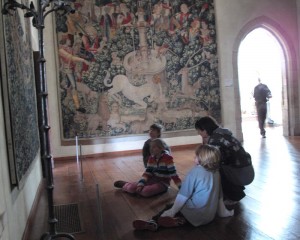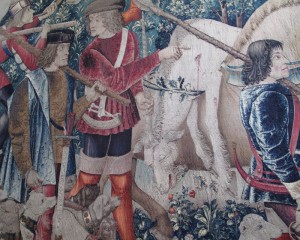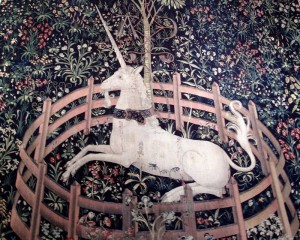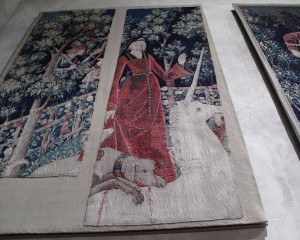Post Category Paul on 06 Dec 2009 08:01 pm
Unicorn Chasing
Alright, it’s been so long since I last updated this that the spambots have begun circling like buzzards, and it’s becoming more effort to delete their comments than to just post something new. Hopefully when they see signs of life, they’ll move on (though if you need discount pharmaceuticals, I can put you in touch with someone who desperately wants to sell them to you).
This is kind of neat:
I recently visited the Cloisters, which is a branch of the Metropolitan Museum of Art way up at the very northern tip of Manhattan. It’s home to a lot of their medieval collection, and I went mainly to stare at the Unicorn Tapestries.
 This is a group of seven tapestries that were woven in the Netherlands approximately 1495-1505. It’s not clear that they were all originally part of the same set, but they’ve been together for hundreds of years. Each depicts one or two scenes in the hunt for a unicorn involving all the folk of a castle. The pictures include many layers of Christian and Pagan symbolism, not all of which are still understood, and when you get within a few inches of them they reveal more detail than you can absorb in a single visit. They fascinated me when I first found them ten years ago; since then I’ve discovered the beautiful stories of Peter S. Beagle and learned that these tapestries inspired some of his best known work.
This is a group of seven tapestries that were woven in the Netherlands approximately 1495-1505. It’s not clear that they were all originally part of the same set, but they’ve been together for hundreds of years. Each depicts one or two scenes in the hunt for a unicorn involving all the folk of a castle. The pictures include many layers of Christian and Pagan symbolism, not all of which are still understood, and when you get within a few inches of them they reveal more detail than you can absorb in a single visit. They fascinated me when I first found them ten years ago; since then I’ve discovered the beautiful stories of Peter S. Beagle and learned that these tapestries inspired some of his best known work.
Tapestries are apparently a lot more portable and durable than paintings. These were looted during the French Revolution, and when they were discovered generations later, they were in a barn, being used to cover potatoes.
Although many huntsmen pursue the unicorn, it eludes them until it is caught by a virgin. The huntsmen kill it and bring it back to the castle.
In the final tapestry, the unicorn is resurrected; this is an obvious reference to Christ, but since the unicorn is now in contented captivity with a collar around its neck, it’s thought to also represent a newlywed groom. (At least some of these were commissioned to celebrate a marriage, possibly that of Anne of Brittany to Charles VIII.)
(In this scene, those red streaks aren’t blood; they are dripping juice from the pomegranates above it, which also represents rebirth.)
The fifth tapestry, the one in which the virgin captures the unicorn in a rose garden, was heavily damaged, and just two strips of it remain. You can’t actually see the virgin now, and you have to guess what she might have looked like; all that’s visible is her hand on the back of the unicorn’s neck as he gazes up at her, oblivious to the attacking dogs. (I wonder — did someone cut her out of the piece to make a medieval pin-up?) The tarty-looking woman behind them seems to be her maid. She’s calling one of the huntsmen, but her come-hither expression suggests she’s thinking about more than just the unicorn.
One Response to “Unicorn Chasing”



on 21 Dec 2009 at 5:56 pm # Arlene
Remind me next week to tell you about the lovely unicorn tapestries in the Cluny Museum in Paris.
I love our unicorn tapestries too and was very interested in seeing those. They too are lovely, but much sweeter. It’s an ode to the 5 senes (with maiden, unicorn and lion–you have never see such a sweet smile on a little lion!)
http://homepages.luc.edu/~avande1/unicorn.html#